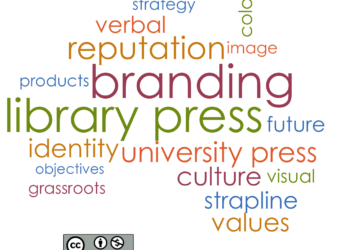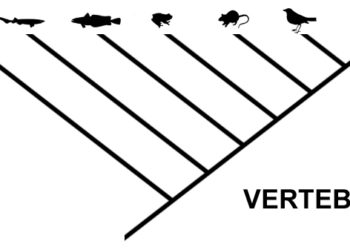Editor’s Note: Below find two posts from 2013, each taking different points of view on partnerships and collaborations between university presses and university libraries. The first, by Joe Esposito, was titled Having Relations with the Library: A Guide for University Presses. The second, written in response, is from Rick Anderson, titled Another Perspective on Library-Press “Partnerships“.
Having Relations with the Library: A Guide for University Presses
Joe Esposito
It’s quite fashionable nowadays to talk of collaboration between university presses and libraries. Indeed, an increasing number of presses now report into the library. Oddly, as far as I know the situation is never reversed–that is, no library reports into a press even when the press is as large or larger than the library (Oxford, Cambridge, and perhaps Chicago and Johns Hopkins). It’s taken for granted that publishers, at least academic ones, and libraries have a great deal in common and that putting them together organizationally will yield multiple benefits — cost savings, say, or new products and services or even an entirely new business model. The question I have is what exactly are such collaborations supposed to accomplish and whether cooperation between a library and a press is the best way to achieve that goal.

Vonnegut in his 1963 novel Cat’s Cradle), is defined as a “false karass”. That is, it is a group of people who outwardly choose or claim to have a shared identity or purpose, but whose mutual association is actually meaningless. Image via R.
Outside the academy we hear of collaborations and joint ventures all the time. I doubt that there is any more overused word in commerce than “partnership.” A “partnership,” alas, is often a euphemism for an unequal relationship, perhaps one where organization A sells something to organization B or even when A acquires B. You know you are not in a partnership when you get a memo to be in someone’s office at 8:00 the next morning. Let’s choose our words carefully and not invoke partnerships and collaborations when in fact we mean simple vendor-customer relationships or a matter of one unit being subordinated to another. When a library forms a partnership with a press, what exactly is involved? What is the substance? What value is being added by putting the entities together even if only for a limited time on a single project?
Let’s take an example from another area to help us study this problem abstractly. Perhaps the CEOs of Microsoft and Federal Express meet on the golf course and, later, over drinks — over a lot of drinks — conclude that they should establish a strategic partnership. They return home and put together teams to work together on the partnership. The first proposal: FedEx will standardize all its productivity software on Microsoft Office and its collaboration software on SharePoint. Would that be a partnership? No, it would simply be a vendor-customer relationship, with Microsoft serving as the vendor.
Proposal #2: Microsoft will take on FedEx as its preferred organization to manage package delivery and logistics. Is that a partnership? No, it’s but another vendor-customer relationship, this time with FedEx as the vendor. To get to a true partnership Microsoft and FedEx have to do something that they could not do before and that they cannot do with other organizations.
Proposal #3: We at FedEx have developed our own logistics management software, which we bet would be useful to people in other industries that do not compete with us. Let’s have Microsoft develop this software as a commercial product and market it. We can then share in the profits.
This is a different story and it would indeed constitute a true partnership. Each party is putting certain assets into the venture (domain knowledge of logistics on FedEx’s part, knowledge of software development and marketing on Microsoft’s end). They share the risk and they share the rewards.
The fact is that when you look at any organization from the outside, all you really see is the brand. Apple or Google or Procter & Gamble appear as huge edifices, but what goes on inside? Partnerships are created by peeling back the brand and looking at all the operations. Peel back the brand of a great research library, for example, and you see various functional areas: collection development, metadata management, copyright expertise, preservation and restoration areas, and so on. Peel back the brand of a university press and you see a collection of copyrights; a network of authors, reviewers, and distributors; a virtual print supply chain; and a series of workflows that begin with the original manuscript and end with the purchase of a book. If there is a partnership to be forged here, it’s on the level of the functional areas.
So, for example, many presses are pleased to collaborate with libraries because libraries have expertise in hosting Web services. Let’s think about that for a minute. Do libraries uniquely possess those IT skills? I doubt it. Which leads to the next question: If the press is getting IT services from the library, what other vendors were asked to bid on the project? Is the institution’s library the best IT shop in the county? Here we have an example of what is essentially a vendor relationship masquerading as a partnership. The fact is that this is a mercantilist economy: the press uses the library’s IT development staff because it is locked into the same system, the same institution. The library is not asked to compete with other IT shops to get the press’s business.
Let’s look at an example in the other direction. A library is the lucky recipient of the papers of a great writer. These are unique documents. The library undertakes to digitize and edit the papers. As there is no endowment to cover the ongoing maintenance of the collection, the library determines that the digital edition will be sold on a subscription basis to other libraries. The press is then recruited to oversee the publication of the work and the establishment of the appropriate commercial relationships. Is this a partnership?
Once again we have a fairly conventional economic arrangement. In this instance the library acts as the author and the press as the publisher. There is nothing wrong with this — indeed, I would like to see presses become much more active in the publication of digital editions of special collections — but it is not a new way to conduct business. The question the library should be asking in this instance is not whether it needs a publisher to create a market for the digitized collection (the answer to that is almost certainly yes) but whether the university press is the best publisher to work with. Authors shop around for the best publisher all the time: should not libraries do the same? Perhaps the library is better off going with a different publisher, even a commercial one. Relationships that are forged as part of mercantilist economies are often unhappy in their own way, as there is no competitive drive to find the very best organizations to work with.
The example of the digitized special collection could be made into a true partnership, however. For example, the idea for the project could originate with the press. An editor might instruct the library on the collection’s market potential and help shape its development. In this instance the press is being competitive by adding editorial value. To do this, however, there is no need for the press to report to the library or vice versa. The arrangement can be handled with a simple memorandum. This is, in other words, an arrangement between two parties. No organizational change is necessary to put this project into effect.
Sometimes a press is made to report into the library for administrative reasons. Most presses are small potatoes on a university campus; they cost the university almost nothing (the myth of bleeding university presses is sheer nonsense). Suppose we have a more or less typical press with revenue of $5 million a year, which operates at a loss of $500,000. That is, the press earns most of its funding in the marketplace and is then subsidized by the parent for the remainder. A half-million dollars is a blip in the budget of a research university, so rolling that department into the much larger budget of a library (perhaps $35 million each year, with almost no earned revenue) tidies things up. This is the very worst reason to make an organizational change, but it is common in both the not-for-profit and commercial spheres. Every level in an organization should add value to the units below it. The point of a reporting relationship is not for the superior to “keep an eye” on the subordinate but for the superior to assist the subordinate in doing even better work.
Every way you look at the relationship between a press and a library, you come away with little or nothing to support an organizational marriage. Presses are great things, libraries are great things, but they are not better things by virtue of having been put into the same organization. So much of what each entity does is of no use to the other. What, for example, is a library to make of a press’s internal management report that lists all trading accounts in terms of the days outstanding for receivables? Does a library even have to know what a receivable is? Libraries can advise presses on library markets, metadata development, and the latest developments in identifiers (e.g., ISTC)–but here we must quickly ask, are libraries the best advisors for these tasks? Both libraries and presses are better off pursuing their own aims, cooperating when it is useful, working separately when it is not. Surely it is not out of line to ask: Why can’t we just be friends?
Another Perspective on Library-Press “Partnerships”
Rick Anderson
Last week [now above], Joe Esposito wrote a thought-provoking piece about what we mean when we talk about “partnerships” and “collaborations” between libraries and university presses — particularly when the university press is absorbed into the library itself — and about whether such arrangements really make sense. In his concluding paragraph, Joe offers this observation:
Every way you look at the relationship between a press and a library, you come away with little or nothing to support an organizational marriage.
Now, I agree with Joe that when it comes to library-university press relationships, the term “partnership” is often used casually and inaccurately. But to my mind, the important question is not whether that relationship can accurately be called a partnership. The question is whether the relationship (whatever it may be at a particular institution, and whatever we choose to call it) makes sense: is it truly mutually beneficial, and is it structured in such a way as to offer the greatest possible mutual benefit? Call it a partnership, call it a collaboration, call it a pastrami sandwich — the question is, does it work to everyone’s advantage? Joe is skeptical and offers some good reasons for his skepticism, but I’d like to offer a different perspective on that question.

First, to be clear about the context of my comments: what we have in my institution is a reporting relationship. The University of Utah Press (UUP) is an agency of the J. Willard Marriott Library. No one here refers to this relationship as a “partnership” or a collaboration (except colloquially, in casual conversation); everyone understands it to be a subsidiary relationship. The UUP’s director reports to the dean of the library, and sits on the library’s Executive Council alongside the associate deans and the directors of human resources and external relations.
From my vantage point as one of those associate deans and, for the past eighteen months, interim dean of the library, I’ve seen a number of significant benefits from this relationship. Four of these include:
Shared equipment and expertise. Ours is one of the relatively few research libraries that owns an Espresso Book Machine, and the opportunities for mutually-beneficial use of that machine by the library and the press are potentially huge — but they won’t be fully realized unless the press and library are working together very closely. Similarly, the library has digitization staffing and equipment that can be (and, in our case, have been) of great use to the press. Having the press and library working out of the same budget bucket makes such cooperation quite a bit more efficient and convenient than it would be if it required shifting money between discrete campus entities. For example: many research libraries (including ours) are experimenting with publishing projects. When we undertook digital and print-on-demand publication of some of our handwritten pioneer diaries a few years ago, we called on UUP experts to give us input on design and layout questions. When UUP wanted to make its long-out-of-print Anthropological Papers series available to the marketplace again, it called on the library to help with digitization and formatting and, with use of the Espresso Book Machine, to make printed copies available on demand. Could the library have gotten layout and design help from elsewhere? Could UUP have used some other service provider for POD? Sure. But in both cases it would have required establishing new relationships with new vendors, the creation of service agreements, the solicitation and payment of invoices, and the spending of money. Instead, the work was accomplished quickly and easily and the only costs involved were opportunity costs.
Overlapping and complementary strategic perspectives. Despite the intimate, mutually-dependent relationship that exists between them, librarians and publishers do not understand each other. In my experience, librarians tend to have only the most simplistic understanding of the work publishers do, and publishers very often utterly misunderstand the institutional context, motivations, and structural responsibilities of librarians. Given this reality, it has been wonderful to see what happens when a press director and library administrators are at the same table, week after week, discussing issues related to collection development, market practice, and scholarly communication. The mutual reality-checks that happen in these meetings are invaluable; they make the library leadership better librarians and the UUP a better press.
Leveraging the travel budget. The press director attends regional and national meetings to which we might wish to send a librarian, but probably would not because of competing priorities and a limited travel budget. The fact that the press is part of the library means that the library has someone at, for example, the AAUP meeting — someone who can report back and give us a different perspective on what’s happening in the university press community. The same is true in reverse for librarians’ meetings such as ALA. Here again, both the library and the press benefit from the close working relationship that is naturally fostered by the organizational integration of the two units.
Access to space and staff support. By being both physically and organizationally a part of the library, our university press benefits from relatively easy access to prime event and meeting space (and the staff support that comes with it) for access to which other entities on campus must a) pay and b) compete with each other. If this sounds like a minor consideration, then you probably don’t work on a university campus.
I can imagine a couple of objections to the examples I’ve provided above.
First, none of the benefits I’ve described necessarily requires the press to report to the library — all of them could, presumably, be realized just as effectively if the reporting line went the other way. I freely concede that point. If I had to hazard a guess as to why, when they are put together, presses are invariably made subordinate to libraries, I suppose I would say it’s because libraries are always so much bigger, and it probably never occurs to anyone to put the press in charge of the library. We generally expect the bigger fish to eat the smaller one, not vice versa. I’m not saying this is right or wrong.
Second, few of the benefits I’ve described above absolutely require the integration of the university press into the library or a direct reporting relationship from the press director to the library dean. As Joe says, many of these arrangements could be “handled with a simple memorandum.” But while the memorandum itself could be simple, a lot of less-simple things have to happen before it can be written, and it seems to me much more likely that those things will happen if the press and the library are structurally connected — their leadership meeting together frequently and regularly, issues of mutual concern being discussed constantly, and initiatives and projects being carried out in an environment of close mutual association.
I don’t know that such a relationship can accurately be called a partnership, nor do I think that matters much. What I’m interested in is whether having the University of Utah Press situated in the library makes the University of Utah a better place for students and scholars and makes the larger scholarly community a richer source of knowledge. It seems to me that, in our case at least, it does. For other institutions, I’m sure the mileage will vary — by no means am I arguing that every university press ought to report to a library. But it seems to work very well here, for reasons that are probably not readily apparent to those outside of our institution.
Discussion
4 Thoughts on "Revisiting Two Perspectives on Library-based University Presses"
Great discussion. I am not too sure if Rick knows what a publisher is. Publishing is not manufacturing a manuscript. Why would a library invest in a manufacturing machine and then say we better utilize it so lets have the university press report to us so that we can justify our purchase!
Publishing is the marketing of that which is produced. Publishers, dare I say it, are simply marketers. Now the library can say in my institution we look at this or that or we want to bb able to do this or that but what that library looks at is not what another library looks at.
The library is but one part of a market – does the library know what the general public is looking for or what a specific public is looking for. In short, the librarian provides a narrow view of a market.
What does the dean of a library know about marketing or for that matter publishing? In short, what does the dean bring to the table to make the publisher more successful? On the other hand what does the publisher bring to the table? The publisher can listen to the librarian and say that is an interesting idea now what does it cost and who else will buy it?
The women’s softball team may be a money loser for the athletic program but no one would suggest that it should report to the director of the women’s studies program!
I am not too sure if Rick knows what a publisher is.
I do. Thanks for checking.
Publishing is not manufacturing a manuscript.
Couldn’t agree more. Manufacturing a manuscript is what we in the business typically refer to as “authorship.”
Why would a library invest in a manufacturing machine and then say we better utilize it so lets have the university press report to us so that we can justify our purchase!
Why indeed? Luckily, I’m not aware of any library that has done anything of the sort.
One starting point for examining this question about the potential benefits of library/press cooperation is the Ithaka Report of June 2007 on University Publishing in a Digital Age: http://www.sr.ithaka.org/wp-content/uploads/2015/08/4.13.1.pdf Joe knows this very well because he talked about it as a member of a panel at the AAUP annual meeting that very month. The Report includes a very useful Appendix B titled “Comparison of Press and Library Strengths and Weaknesses,” which shows exactly what kinds of synergies can be realized from collaboration between these two units of a university. Joe is right that there is a wide spectrum of possible relationships built on these synergies, from cooperation on just an isolated project or two all the way to full-blown administrative merger. And administrative merger does not necessarily entail much cooperation, as we have examples of such reporting relationships with minimal cooperation, as at MIT, which Joe knows well because he served on the board of the press there. And wide-scale cooperation does not require administration merger, as the example of the University of California Press and the library there shows. When a real partnership develops, it sometimes arises from a shared vision about the future of scholarly communication. This happened in the CIC (now the Big Ten Academic Alliance) when the press directors and library heads began meeting regularly in the early 1990s to discuss where electronic publishing was headed and how it might lead to “open access” as a model for monograph publishing, especially to help save what had come to be known as “endangered species,” fields where monograph publishing had fallen on hard times and opportunities for young scholars to get their books published had grown scarce. These meetings eventually resulted in a proposal to the Mellon Foundation in 1996 to fund a cooperative project in the CIC to experiment with this approach in three fields. Though the project was not funded (principally because Mellon had just funded JSTOR and Project Muse and didn’t want to fund any more projects at the time), it did provide inspiration for some of the presses involved to develop their own projects in electronic monograph publishing–and I think it is no accident that those presses that pursued these projects all became merged with their libraries–Michigan, Penn State, and Purdue. The mergers differed in certain respects. At Penn State, where I was director, the press’s budget was kept separate from the library’s; I don’t believe that was the case for Michigan. But they all became full-fledged partnerships. At Penn State we formalized our cooperation in spring of 2005 in the Office of Digital Scholarly Publishing (ODSP), which actually was established six months before the administrative merger came about. A full history of the development of the ODSP out of the CIC collaboration is provided in my essay on “Open-Access Monograph Publishing and the Origins of the ODSP” in the April 2015 issue of the Journal of Scholarly Publishing, accessible here: https://scholarsphere.psu.edu/concern/generic_works/x346dv41v
I own 15 books published by the University of Utah Press. With one exception (Claude Barnes’ _The Natural History of a Mountain Year_) the production quality of these books is immaculate. If, as Rick seems to be suggesting, U of U Press were to begin using the Espresso Machine to publish its books, I would stop being a customer. The fact that the U of U Press proudly publicizes the Book Design and Production awards it has won gives me some hope that it won’t go down that road.



